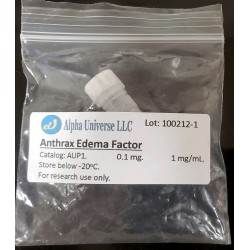Bacillus anthracis
Anthrax toxin is the causative agent of anthrax. It is a three-component exotoxin produced by virulent strains of Bacillus anthracis. Anthrax toxin consists of three nontoxic proteins that associate in binary combinations to form toxic complexes at the surface of mammalian cells. The three proteins of the exotoxin are 83 kDa Protective Antigen (PA), 90 kDa Lethal Factor (LF), and 89 kDa Edema Factor (EF).
Assembly of the toxic complexes begins when PA binds to a cellular receptor and undergoes cleavage by cell protease Furin. As a result, two fragments of PA are generated: an amino-terminal 20-kDa segment of the protein (PA20) that is released, and the carboxyl-terminal 63-kDa fragment (PA63) that remains bound to receptor. Unlike native PA, PA63 forms a ring-shaped heptamers and gains the ability to bind up to three copies of EF and/or LF . Such complexes undergo endocytosis. In the endosomal compartment, the acidic pH causes a conformational change that, eventually, lead to translocation of LF and EF into the cytoplasm.
LF and EF are enzymes. The LF is a Zn2+-dependent protease that cleaves members of the Mitogen-Activated Protein Kinase Kinase family (MAPKK) near to their amino termini. Cleavage of the MAPKKs interferes with MAPK signaling and induces apoptosis. EF is a calmodulin-dependent Adenylate Cyclase. It affects cell homeostasis via catalyzing conversion of ATP into cAMP.




